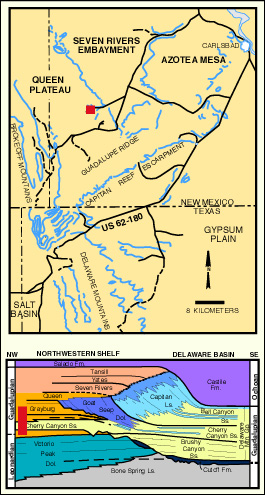
Permian Reef Complex Virtual Field Trip
Stop III-8: Sitting Bull Falls


© Peter A. Scholle, 1999

© Peter A. Scholle, 1999
Sitting Bull Falls. Lunch stop at picnic benches. The entire cliff on the northwest side of the picnic area is formed of modern travertine which can be examined in numerous fallen blocks. A short walk to the active waterfall area shows travertine in the process of formation (see photo). Calcium bicarbonate and carbon dioxide saturated waters emerge from springs in the Grayburg and San Andres units a short distance (about 0.6 km; 1 mi) upstream from the falls. Warming of the waters, combined with release of CO2 from waters plunging over the falls, induces precipitation of calcium carbonate. The withdrawal of CO2 from the water by the numerous algae and higher plants which abound at the falls also contributes to the calcite precipitation. These plants are then incorporated within the calcite, later to rot away. This accounts for the unusual, porous fabric with abundant impressions of leaves and stems seen in the travertine blocks (see photo).

© Peter A. Scholle, 1999
If you climb up or under the waterfalls, please take great care as the rocks here are very slippery. The other walls of the canyon in this area expose the Cherry Canyon sandstone tongue in their lower part, the upper San Andres Limestone in the middle part, and Grayburg Fm. in the upper part. Note what look like biohermal or bank structures in the San Andres; they are fusulinid grainstone banks rather than reefs. If you climb to the top of the waterfalls you will be able to see that what look like isolated bioherms are really part of a shelf margin bank which is rolling over the prograding shelf-slope break and which has been irregularly dissected by the canyon (see photo). If you climb still farther up you will be able to see some large-scale channels in the Cherry Canyon slope facies as well as the tidal (herring-bone) cross-bedding and shallowing upward sequences of the topset beds of the San Andres Formation. For more detailed descriptions of this area see Harrison (1966), Naiman (1982), McDermott (1983) or Sarg and Lehmann (1986a).
Return down-canyon to the El Paso Gap-Carlsbad road.
Return to Dark Canyon-Sitting Bull Falls-Rocky Arroyo Roadlog


